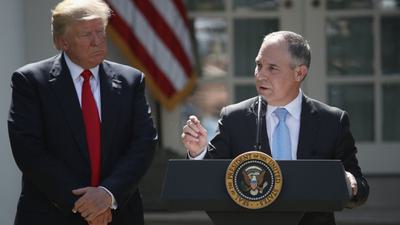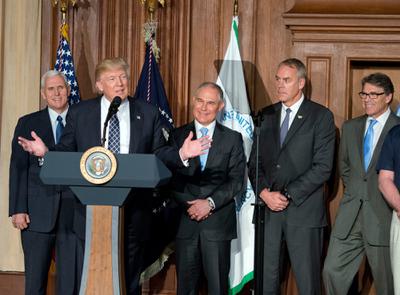Pruitt is directing the EPA to bend conventions of economic analysis in support of a deregulation agenda.
Since the early 1980s, beginning with a directive from President Ronald Reagan, there has been a bipartisan consensus on the need for cost-benefit analysis for significant policy changes. The rationale, rooted in conservative thinking, is quite simply that the benefits of any regulatory action should outweigh — or at least justify — the costs. Having to compare the costs and benefits helps ensure that regulations make society better off on balance, while also serving as a check to prevent over-regulation.
So far, the Trump administration has focused on eliminating existing environmental regulations rather than proposing new ones. The past year has therefore offered an unprecedented opportunity to compare how two different administrations carry out cost-benefit analyses for the same environmental regulations. The contrast is striking, and provides a window into how Pruitt is directing the EPA to bend conventions of economic analysis in support of a deregulation agenda.
Take implementation of the federal Clean Water Act, first passed in 1972 with bipartisan support and signed by President Richard Nixon. In 2015, the EPA issued a rule to clarify longstanding uncertainty about which waters were subject to provisions of the act. What came to be known as the WOTUS rule — standing for Waters of the United States — expanded the number of covered streams and wetlands because of their connectivity to waters explicitly covered in the original act. The scientifically based idea was that keeping “navigable” waters clean obviously requires some consideration of the small streams and wetlands that flow into them.
As part of the WOTUS rulemaking, Obama’s EPA released its required economic analysis and found that the anticipated benefits of about $450 million per year would exceed the annual compliance costs of nearly $300 million. The vast majority of benefits were those associated with protecting wetlands, including essential services such as flood control, water quality improvements, fish and wildlife habitat, groundwater recharge, and recreational opportunities.
Wetlands in the Bristol Bay watershed in Alaska. Under Scott Pruitt, the EPA has moved to remove Obama-era wetlands protections under the Clean Water Act. U.S. EPA
Then in June 2017, the Trump administration’s proposal to rescind WOTUS included its own analysis, which came to the opposite conclusion about the benefits exceeding the costs. In the new analysis, the quantified benefits for the identical policy were estimated at only $50 million per year — a reduction of nearly 90 percent — while the costs remained the same.
What explains the discrepancy? The EPA under Pruitt’s leadership asserted, with surprisingly little justification, that the 10 studies used to estimate the range of benefits associated with wetlands protection were not recent enough to sufficiently reduce uncertainty. All of the studies were conducted between 1986 and 2000, and while there are well-established techniques to update the results of such studies, none were used, nor did there appear to be any effort to search for more recent studies. The result was simply to assign a value of $0 to the largest category of ecological benefits that had been valued by the same agency two years earlier at more $400 million per year. In effect, zeroing out these benefits made it a foregone conclusion that the rule would not pass a benefit-cost test.
The contrast between administrations is no less stark when it comes to the Clean Power Plan. Finalized in 2015, the plan calls for a reduction in carbon emissions from U.S. power plants of 32 percent by 2030. Obama’s EPA estimated that the annual cost of meeting this goal by 2030 would be $8.4 billion, but calculated that the benefits were far greater — ranging from $34 billion to $54 billion.
The benefits come from two sources: First is the avoided damage of climate change. Since 2009, the EPA and other government agencies have measured climate damages using something called the social cost of carbon. This measures the monetary damages that a ton of emissions has on a variety of sectors, including agriculture, health, and employment. It also accounts for damages that are expected from the increased frequency and severity of storms, sea level rise, and flooding — climate-related threats with significant costs that were evident last summer when Hurricane Harvey slammed into Houston and other hurricanes devastated Puerto Rico and the Caribbean.
The second category of benefits from the Clean Power Plan is based on the health effects of simultaneously reducing other air pollutants that create dangerous soot and smog. Because of the way electricity is generated, reducing carbon dioxide emissions from power plants means that other harmful air pollutants — including sulfur dioxide, nitrogen oxides, and fine particulate matter — would be reduced as well. This means that there would be fewer premature deaths, asthma and heart attacks, hospital visits, and missed days at school and work.
The Trump administration’s analysis of the Clean Power Plan fails to account for impact of climate change on Americans.
In October 2017, the Trump administration released a proposed repeal of the Clean Power Plan, along with a dueling economic analysis. Despite the climate skepticism of both President Trump and administrator Pruitt, denial was not a defensible basis for eliminating the Clean Power Plan. The EPA is legally obligated to regulate carbon emissions under the Clean Air Act because the EPA, in response to a Supreme Court ruling, issued a finding in 2009 that greenhouse gases endanger the health and welfare of current and future generations.
Instead, the Trump administration’s revisionist economic analysis considers an array of scenarios to contend that the costs of the Clean Power Plan outweigh the benefits. Many of these calculations are based on assumptions that push the boundaries of standard analysis related to what counts as a cost of climate change, the measurement of health effects, and concern for future generations. Wherever and whenever reducing emissions are expected to provide substantial public benefits, the Trump administration has changed the accounting to significantly narrow the scope of what is counted.
For example, the Obama administration measured the social cost of carbon using global damages. The reason is that climate change is a global problem, and the costs and benefits to the United States are intertwined with the actions of other countries.
President Trump at a ceremony last March for his signing of an executive order reversing climate policies of the Obama administration. Ron Sach-Pool/Getty Images
But the Trump administration counts only those damages that occur within the U.S. — and the difference is substantial. Using the narrowly focused parameters of the Trump administration, the cost of a ton of emissions in 2030 falls from $54 a ton to $7 — a reduction of 87 percent. While this may at first appear consistent with an “America first” strategy, it is shortsighted and fails to account for the global nature of the problem and its impact on Americans.
The Trump administration also casts doubt on how and whether the EPA should include the health benefits from the reduction of other pollutants. In one scenario, it asserts the dubious assumption that the reduction of pollutants below their regulated levels has no human health effects worth counting. More generally, and in contrast to standard practice, the EPA’s revised analysis even argues that health co-benefits should not count at all because they are not directly tied to the target pollutant of carbon dioxide. The indefensible argument here is that we should simply ignore the way that reducing the emissions of carbon dioxide from power plants simultaneously reduces other pollutants, which makes people healthier.
Another significant change is that the Trump administration underplays the future costs of climate change. It does so by playing with the “discount rate,” which affects the value of things that happen in the future. The discount rate has critically important consequences for climate policy: The reason for reducing emissions is to avoid future climate damages, and a higher discount rate diminishes how much weight is given to those future damages.
Vigorous court challenges are expected, with questions raised about the legal basis of the EPA’s abrupt about-face in decision-making.
The Obama administration focused on scenarios with a standard discount rate of 3 percent. The Trump administration includes scenarios with a discount rate of 7 percent, thereby placing significantly less weight on future climate damages. By the year 2030, using this rate shrinks the social cost of carbon to a mere $1 per ton, down from what was initially $54 when using more broadly accepted scenarios about what reasonably counts as a cost of climate change, in addition to the discount rate. The Trump administration approach also produces scenarios where the Clean Power Plan begins to show annual net losses of $9 billion to $13 billion by 2030.
The Clean Power Plan and the Waters rule are arguably two of the Obama administration’s most significant environmental regulations. Now, the Trump administration is working to repeal them both, following a clear pattern whereby Pruitt’s EPA is altering standard assumptions and methods of cost-benefit analysis to flip the outcome and build its case.
Vigorous court challenges are sure to follow, led by environmental groups questioning the legal basis of the EPA undertaking such an abrupt about-face in decision-making that is supposed to be anchored in evidence-based analysis. It will be up to the Trump administration to argue that the EPA’s actions satisfy the legal criteria of a “reasoned explanation” or are not “arbitrary or capricious.” An important vulnerability is likely to be the administration’s questionable cost-benefit calculations.
By downplaying the benefits and exaggerating the costs of Obama-era environmental rules, the Trump administration is not only revealing its motivations, it is also eroding the credibility of government agencies to produce objective analysis. In the long run, unfortunately, that could cause far more damage than the short-term political swings of repealing and replacing individual regulations.





